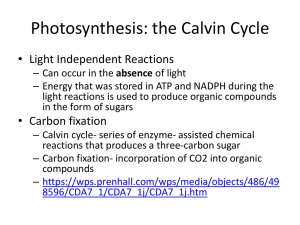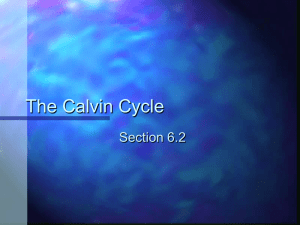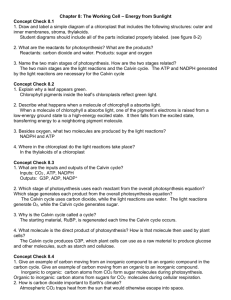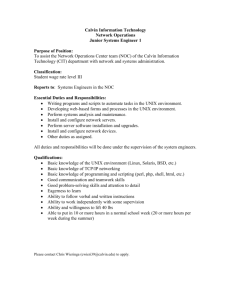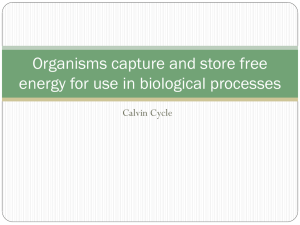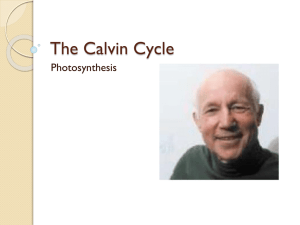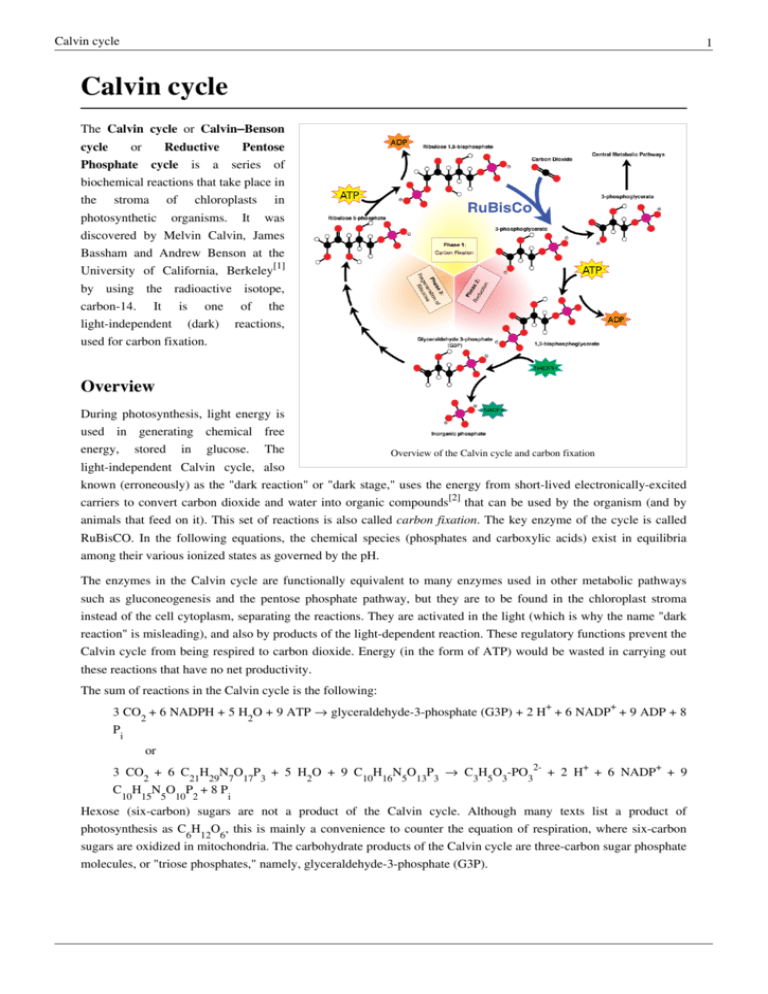
Calvin cycle
1
Calvin cycle
The Calvin cycle or Calvin–Benson
cycle
or
Reductive
Pentose
Phosphate cycle is a series of
biochemical reactions that take place in
the stroma of chloroplasts in
photosynthetic organisms. It was
discovered by Melvin Calvin, James
Bassham and Andrew Benson at the
University of California, Berkeley[1]
by using the radioactive isotope,
carbon-14. It is one of the
light-independent (dark) reactions,
used for carbon fixation.
Overview
During photosynthesis, light energy is
used in generating chemical free
energy, stored in glucose. The
Overview of the Calvin cycle and carbon fixation
light-independent Calvin cycle, also
known (erroneously) as the "dark reaction" or "dark stage," uses the energy from short-lived electronically-excited
carriers to convert carbon dioxide and water into organic compounds[2] that can be used by the organism (and by
animals that feed on it). This set of reactions is also called carbon fixation. The key enzyme of the cycle is called
RuBisCO. In the following equations, the chemical species (phosphates and carboxylic acids) exist in equilibria
among their various ionized states as governed by the pH.
The enzymes in the Calvin cycle are functionally equivalent to many enzymes used in other metabolic pathways
such as gluconeogenesis and the pentose phosphate pathway, but they are to be found in the chloroplast stroma
instead of the cell cytoplasm, separating the reactions. They are activated in the light (which is why the name "dark
reaction" is misleading), and also by products of the light-dependent reaction. These regulatory functions prevent the
Calvin cycle from being respired to carbon dioxide. Energy (in the form of ATP) would be wasted in carrying out
these reactions that have no net productivity.
The sum of reactions in the Calvin cycle is the following:
3 CO2 + 6 NADPH + 5 H2O + 9 ATP → glyceraldehyde-3-phosphate (G3P) + 2 H+ + 6 NADP+ + 9 ADP + 8
Pi
or
3 CO2 + 6 C21H29N7O17P3 + 5 H2O + 9 C10H16N5O13P3 → C3H5O3-PO32- + 2 H+ + 6 NADP+ + 9
C10H15N5O10P2 + 8 Pi
Hexose (six-carbon) sugars are not a product of the Calvin cycle. Although many texts list a product of
photosynthesis as C6H12O6, this is mainly a convenience to counter the equation of respiration, where six-carbon
sugars are oxidized in mitochondria. The carbohydrate products of the Calvin cycle are three-carbon sugar phosphate
molecules, or "triose phosphates," namely, glyceraldehyde-3-phosphate (G3P).
Calvin cycle
Steps of the Calvin cycle
1. The enzyme RuBisCO catalyses the carboxylation of ribulose-1,5-bisphosphate, a 5-carbon compound, by carbon
dioxide (a total of 6 carbons) in a two-step reaction.[3] The initial product of the reaction is a six-carbon
intermediate so unstable that it immediately splits in half, forming two molecules of glycerate 3-phosphate, a
3-carbon compound[4] (also: 3-phosphoglycerate, 3-phosphoglyceric acid, 3PGA).
1. The enzyme phosphoglycerate kinase catalyses the phosphorylation of 3PGA by ATP (which was produced in the
light-dependent stage). 1,3-bisphosphoglycerate (glycerate-1,3-bisphosphate) and ADP are the products.
(However, note that two PGAs are produced for every CO2 that enters the cycle, so this step utilizes two ATP per
CO2 fixed.)
2. The enzyme G3P dehydrogenase catalyses the reduction of 1,3BPGA by NADPH (which is another product of
the light-dependent stage). Glyceraldehyde 3-phosphate (also G3P, GP, TP, PGAL) is produced, and the NADPH
itself was oxidized and becomes NADP+. Again, two NADPH are utilized per CO2 fixed.
(Simplified versions of the Calvin cycle integrate the remaining steps, except for the last one, into one general step the regeneration of RuBP. Also, one G3P would exit here.)
1. Triose phosphate isomerase converts all of the G3P reversibly into dihydroxyacetone phosphate (DHAP), also a
3-carbon molecule.
2. Aldolase and fructose-1,6-bisphosphatase convert a G3P and a DHAP into fructose 6-phosphate (6C). A
phosphate ion is lost into solution.
3. Then fixation of another CO2 generates two more G3P.
4. F6P has two carbons removed by transketolase, giving erythrose-4-phosphate. The two carbons on transketolase
are added to a G3P, giving the ketose xylulose-5-phosphate (Xu5P).
5. E4P and a DHAP (formed from one of the G3P from the second CO2 fixation) are converted into
sedoheptulose-1,7-bisphosphate (7C) by aldolase enzyme.
6. Sedoheptulose-1,7-bisphosphatase (one of only three enzymes of the Calvin cycle that are unique to plants)
cleaves sedoheptulose-1,7-bisphosphate into sedoheptulose-7-phosphate, releasing an inorganic phosphate ion
into solution.
7. Fixation of a third CO2 generates two more G3P. The ketose S7P has two carbons removed by transketolase,
giving ribose-5-phosphate (R5P), and the two carbons remaining on transketolase are transferred to one of the
G3P, giving another Xu5P. This leaves one G3P as the product of fixation of 3 CO2, with generation of three
pentoses that can be converted to Ru5P.
8. R5P is converted into ribulose-5-phosphate (Ru5P, RuP) by phosphopentose isomerase. Xu5P is converted into
RuP by phosphopentose epimerase.
9. Finally, phosphoribulokinase (another plant-unique enzyme of the pathway) phosphorylates RuP into RuBP,
ribulose-1,5-bisphosphate, completing the Calvin cycle. This requires the input of one ATP.
Thus, of 6 G3P produced, three RuBP (5C) are made, totaling 15 carbons, with only one available for subsequent
conversion to hexose. This required 9 ATPs and 6 NADPH per 3 CO2.
RuBisCO also reacts competitively with O2 instead of CO2 in photorespiration. The rate of photorespiration is higher
at high temperatures. Photorespiration turns RuBP into 3PGA and 2-phosphoglycolate, a 2-carbon molecule that can
be converted via glycolate and glyoxalate to glycine. Via the glycine cleavage system and tetrahydrofolate, two
glycines are converted into serine +CO2. Serine can be converted back to 3-phosphoglycerate. Thus, only 3 of 4
carbons from two phosphoglycolates can be converted back to 3PGA. It can be seen that photorespiration has very
negative consequences for the plant, because, rather than fixing CO2, this process leads to loss of CO2. C4 carbon
fixation evolved to circumvent photorespiration, but can occur only in certain plants native to very warm or tropical
climates, for example, corn.
2
Calvin cycle
Products of the Calvin cycle
The immediate products of one turn of the Calvin cycle are 2 glyceraldehyde-3-phosphate (G3P) molecules, 3 ADP,
and 2 NADP+ (ADP and NADP+ are regenerated in the Light-dependent reactions). Each G3P molecule is composed
of 3 carbons. In order for the Calvin cycle to continue, RuBP (ribulose 1,5-bisphosphate) must be regenerated. So,
5/6 carbon from the 2 G3P molecules are used for this purpose. Therefore, there is only 1 net carbon produced to
play with for each turn. To create 1 surplus G3P requires 3 carbons, and therefore 3 turns of the Calvin cycle. To
make one glucose molecule (which can be created from 2 G3P molecules) would require 6 turns of the Calvin cycle.
Surplus G3P can also be used to form other carbohydrates such as starch, sucrose, and cellulose depending on what
the plant needs[5] .
See also
•
•
•
•
•
Light-independent reaction
Light-dependent reactions
Citric Acid Cycle
Photorespiration
C4 carbon fixation
• Nitrogen Fixation
References
[1] Bassham J, Benson A, Calvin M (1950). "The path of carbon in photosynthesis" (http:/ / www. jbc. org/ cgi/ reprint/ 185/ 2/ 781. pdf). J Biol
Chem 185 (2): 781–7. PMID 14774424. .
[2] Campbell, Neil A.; Brad Williamson; Robin J. Heyden (2006). Biology: Exploring Life (http:/ / www. phschool. com/ el_marketing. html).
Boston, Massachusetts: Pearson Prentice Hall. ISBN 0-13-250882-6. .
[3] (http:/ / www. springerlink. com/ content/ qu357422246r8870/ )
[4] Campbell, and Reece Biology: 8th Edition, page 198. Benjamin Cummings, December 7, 2007.
[5] Russell, Wolfe et al.Biology: Exploring the Diversity of Life.Toronto:Nelson College Indigenous,1st ed, Vol. 1, 2010, pg 151
• Bassham, J.A. (2003). Mapping the carbon reduction cycle: a personal retrospective. Photosynthesis Research,
volume 76, pages 25-52 (see: Entrez Pubmed 16228564 (http://www.ncbi.nlm.nih.gov/entrez/query.
fcgi?cmd=Retrieve&db=pubmed&dopt=Abstract&list_uids=16228564)).Mario Otmman (1998)
• Diwan, Joyce J. (2005). Photosynthetic Dark Reaction at (http://www.rpi.edu/dept/bcbp/molbiochem/
MBWeb/mb2/part1/dark.htm)
• Calvin, Melvin | Article | World Book Advanced at (http://www.worldbookonline.com/advanced/
article?id=ar723267&st=melvin+calvin)
3
Article Sources and Contributors
Article Sources and Contributors
Calvin cycle Source: http://en.wikipedia.org/w/index.php?oldid=395745350 Contributors: ARP, Aa77zz, Adashiel, Adenosine, Alansohn, Aldis90, Animum, Anna krolikiewicz, Anupam,
Apollo1758, Arcadian, Bdodo1992, Benlisquare, Bigwes804, Bob the ducq, Bobo192, Brian Crawford, Bryan Derksen, Bsu0a7, Butterscotch, CERminator, Cacycle, Can't sleep, clown will eat
me, Capricorn42, ChicXulub, ChyranandChloe, Cuahl, DH85868993, David Shear, Dbeardsl, Delta G, Drphilharmonic, Edgar181, El C, Eno-ja, Epbr123, Erpingham, Ettrig, Falcon8765,
Felak47, Firien, Flewis, Frankenpuppy, Fremsley, FreplySpang, Fvasconcellos, G3pro, Gene Omission, Gingekerr, GlassCobra, Gogo Dodo, Granf, GraybeardBiochemist, Guettarda, Gurch,
Gökhan, Hadal, HamburgerRadio, Hfarazdaghi, Idraeus, Ipatrol, Isnow, Ixfd64, J.delanoy, JLaTondre, JWSchmidt, Jackfork, Jean Deaux, Jiang, JoanneB, JuanitaJP, Julesd, KGasso, Keilana,
Kklita, Krylonblue83, La goutte de pluie, Lawrence Cohen, Lbeuschlein, LegitimateAndEvenCompelling, Leyo, Luigifan, Magnus Manske, Mar Garina, MarcoTolo, Mattman723, Monkeyblue,
Mw212, Nakon, Neutrality, Nneonneo, Olavodeepbassyeah, Omnipaedista, Pdcook, PhilKnight, Philip Trueman, Pro crast in a tor, Proficient, Qxz, RA0808, RMFan1, Rammer, Ravichandar84,
RexNL, Roisinb89, ST47, Sango123, Shaddack, Simpsons contributor, Skunkboy74, Sojoho09, Swarm, The Thinkerer, Tiddly Tom, Tide rolls, TimVickers, Unyoyega, White Shadows,
Wickey-nl, Wideheadofknowledge, WikiUserPedia, WikipedianMarlith, Xdenizen, YB3, Ychastnik APL, 357 anonymous edits
Image Sources, Licenses and Contributors
Image:Calvin-cycle4.svg Source: http://en.wikipedia.org/w/index.php?title=File:Calvin-cycle4.svg License: Creative Commons Attribution-Sharealike 3.0 Contributors: User:Adenosine
License
Creative Commons Attribution-Share Alike 3.0 Unported
http:/ / creativecommons. org/ licenses/ by-sa/ 3. 0/
4

